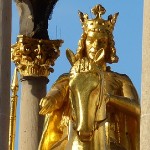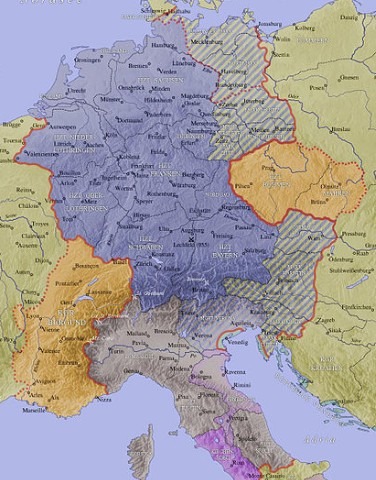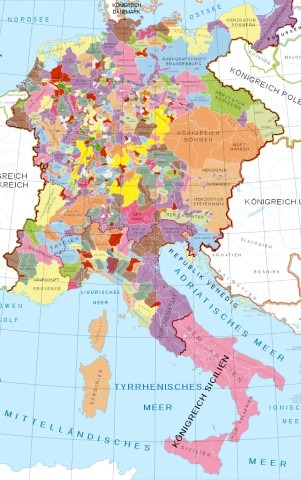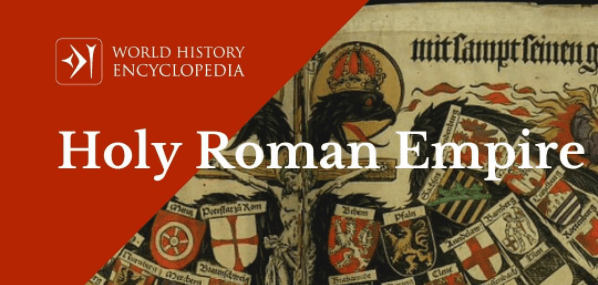MedievalReporter.com
Covering history's most marvelous millennium
Join our newsletter!

Covering history's most marvelous millennium
Covering history's most marvelous millennium
The Holy Roman Empire was perhaps the most complex medieval state that ever existed. Its complicated structure often made it hard to govern. Interestingly enough, this also provided major opportunities for emperors skillful enough to navigate this state of affairs.
On a good day, the Empire was Europe’s most powerful state. On a bad day, it was a patchwork collection of petty lords unable to act in the common interest.
This is a short intro from our Medieval Guidebook. Dive deeper into the subject by reading our articles about it.
The Holy Roman Empire consisted of several building blocks. Originally, its most important territorial areas were the Kingdom of Germany, the Kingdom of Italy and the Duchy of Bohemia. Later, the Empire added a fourth ‘pillar’: the Kingdom of Burgundy. These states combined with smaller political units to form one ‘family of nations’: the Holy Roman Empire. When this family managed to speak with one voice, the rest of Europe listened.

Throughout most of the Middle Ages, the Empire was actually known as universum regnum - meaning “the whole kingdom”. Other names that the Empire carried were “the Christian Empire” or - confusingly - the “Roman Empire”. The Holy Roman Emperors used the latter because they saw themselves as direct successors of the Roman emperors from Antiquity. During the 13th century CE, these names combined into the term Holy Roman Empire.
Although many emperors tried, the “Whole Kingdom” was rarely unified. Its complex nature meant it was more of a confederacy than an empire. Furthermore, the head of the confederacy - the emperor - was elected. The electoral college included three archbishops and the four dukes representing the four “German nations”: Franconia, Swabia, Saxony and Bavaria. These seven lords together held great power. They frequently tried to resist emperors who tried to centralize the Empire’s government.
Fitting for its decentralized nature, the Empire had no permanent capital. The emperors traveled between residences to take care of affairs.

The Holy Roman Empire “started” in 962 CE. It was founded by emperor Otto I. He constructed the Empire on much older foundations, though.

Earlier, during the Early Middle Ages, the Frankish Empire had grown exceptionally powerful. Inspired by the ancient Roman emperors, one of its kings - Charlemagne - had himself crowned Emperor of the Franks. His grandsons ultimately divided his great realm. Its eastern part, called East Francia, evolved into the Kingdom of Germany during the 9th and 10th centuries. Meanwhile, Charlemagne’s title was lost by infighting among his descendants.
As imperial authority thus crumbled, the lords of Germany grew in power. Rather than accepting the king’s son as heir, they started electing their next monarch themselves. In 919, they chose the duke of Saxony as king of Germany. And his son was Otto I. By marrying the queen of Italy, Otto integrated the two kingdoms into an empire. Therefore, he saw fit to revive Charlemagne’s old title and had himself crowned as the first Holy Roman Emperor.
Soon the Empire expanded by adding the other two major building blocks we discussed earlier: Bohemia and Burgundy. The Duchy of Bohemia was situated in modern Czechia. In earlier times, its dukes had already sworn fealty to the East Frankish kings. It was now formally incorporated into the Empire in 1002 by the fourth Holy Roman Emperor, one of Otto’s descendants. Burgundy, in current-day France, “joined” in 1032 when its last king died childless.

- advertisement -
- article continues below -
The Kingdom of Germany made up the bulk of the Empire. The other kingdoms sometimes cooperated to act as one, strong state. More often than not, though, they vied for autonomy and actually resisted the German emperors. Especially in the Kingdom of Italy, political forces - such as the pope - clashed heavily with imperial authorities. To underline their own, seperate identity, the Italians referred to people north of the Alps as “Teutons” or “Germans”.
During the 12th century, Germans also started referring to themselves like that. After this cultural breach, the emperors focused their efforts on the Kingdom of Germany rather than the Empire entire. Over time, it became increasingly uncommon for them to call upon the lords of Italy, Bohemia or Burgundy. The four states followed their own separate paths. Germany, as it happened, was strong enough to stand on its own.
Regardless of the actual power of the emperor, agricultural improvements greatly increased the number of German people. They started pushing east, driving many Slavs from their lands in a process known as Ostsiedlung. In the Empire itself, the number of cities grew. Mercantile alliances and guilds blossomed. Its political structure may have been awkward at times, but the Empire’s economy and culture strengthened and deepened.
Near the end of the Middle Ages, the Empire’s name was finally changed to “Holy Roman Empire of the German Nation”. It would take many more centuries - and, alas, many wars - for the modern Germany to emerge from that.

Disclosure: we work hard to provide you with exclusive medieval reports and guides. To make the Middle Ages accessible to everybody, we’d like this information to remain FREE. Therefore, some of the links below are affiliate links, meaning – at no additional cost to you – we will earn a small compensation if you click through.

Grab a short intro on another civilization from our Medieval Guidebook.